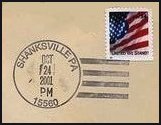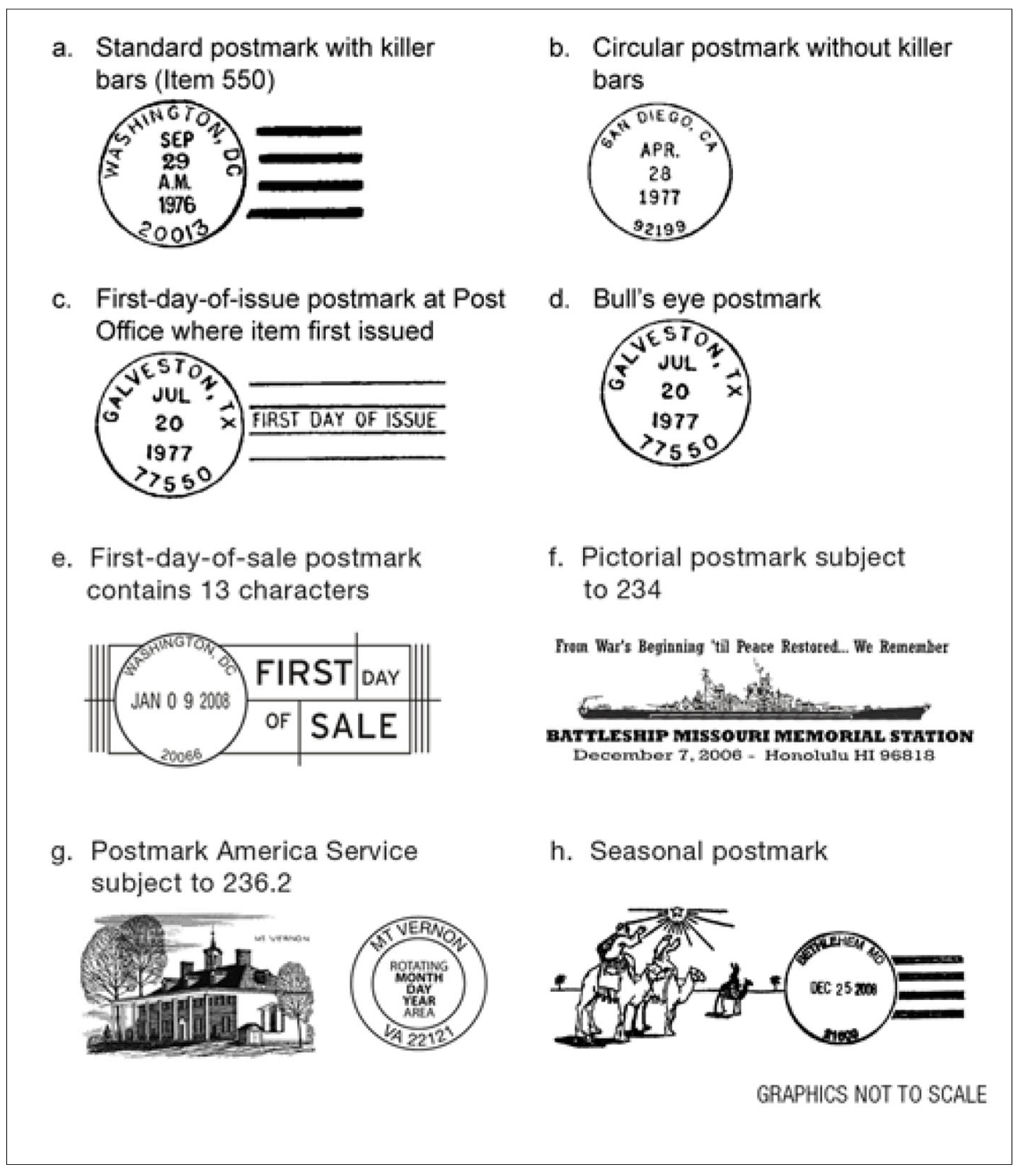
 |
Rules for Collector Cancellations
Not all window clerks know the rules for collector cancellations. When visiting a post office seeking special postmarks, it might be a good idea to bring with you this excerpt from the Postal Operations Manual (POM). The clerk can verify these sections in the office copy of the POM, (POM Issue 9, July 2002, updated with revisions through January 31, 2021).
Rules for Collector Cancellations
 231.3 Cooperation With Collectors
231.3 Cooperation With Collectors
![]()
231.31 Postmarks
Employees should strive to furnish clear and legible postmarks to stamp collectors by ensuring that postmarking machines and hand-stamp devices are properly inked. Postal employees must give special attention to mail bearing an endorsement that it is of philatelic value or to requests for light postmarks, and they should avoid canceling stamps by pen or illegible smudging. However, stamps must be postmarked sufficiently to protect postal revenue.
![]()
231.32 Special Attention
The Postal Service cannot provide special attention to a philatelic cover that has been routinely entered into the mailstream by the sender. To avoid being postmarked in the mailstream, items should be trayed or bagged separately and flagged "nonmachineable" before sending to mail processing.
![]()
231.33 Postmarking Devices
Postmarking devices may be used only under the supervision of authorized postal personnel.
![]()
 231.34 Hand-Stamped Postmarks
231.34 Hand-Stamped Postmarks
All hand-stamped postmarks are made with black ink unless authorized by Stamp Services.
![]()
231.35 Philatelic Covers
Employees should exercise care in handling all philatelic covers to ensure that they are not damaged in mail handling. These covers are generally identifiable by a design (cachet) on the left side of the envelope. To avoid being postmarked in the mailstream, items should be trayed or bagged separately and flagged "nonmachineable" before sending to mail processing.
![]()
231.36 Defacing Philatelic Covers
Postal employees should ensure that philatelic covers are not over-postmarked, backstamped, marked "received this date", or otherwise defaced on front or back; used as a top piece in a bundle for destination-package labeling purposes; or bent, folded, mutilated, or damaged by rubber bands.
![]()
231.4 Hand-Back and Mail-Back Service
Postmarks should be used to provide the following philatelic services whenever they are available:
a. Hand-Back Service
(1) When a customer personally presents an addressed or unaddressed envelope, postal card, or other item described in 231.63 to a postal clerk for postmarking, the Postal Service employee must examine the item to ensure that it is clearly intended for philatelic purposes. Bill payments, tax returns, applications, and/or other date-sensitive mail cannot be handed back. Only after careful examination should a philatelic item be postmarked and handed back to the customer/collector.
(2) The envelope, card, or other item does not enter the mailstream. All such materials requesting postmarking must bear uncanceled postage at the applicable First-Class Mail® rate. If the customer wants to mail the postmarked item, it must be trayed or bagged separately, and flagged
"nonmachinable" to avoid being over-postmarked in processing.
(3) This service may be provided by special die hub or flyer machines only when that particular postmarking machine is readily accessible to the Postal Service employee and only when providing such service does not interfere with other sales or mail processing operations and/or does not inconvenience other customers.
![]()
b. Mail-Back Service
Mail-back service refers to the pictorial postmarking service for stamp dealers and collectors and it allows envelopes, cards, or other items submitted for servicing to be returned in bulk through the mail. To avoid over-postmarking or getting marred in the mail, stamp dealers and collectors must provide either a self-addressed stamped envelope or box for returning the serviced items. For customers submitting fewer than 50 covers who have not enclosed a self-addressed stamped envelope, the postmaster may choose to furnish a protective cover using a G-10 label.
![]()
231.5 Permissible Postmarking Devices and Hand-Stamped
Postmarking for Collectors
he postmark devices shown here may be used to provide hand-
stamped postmarks for collectors:

231.6 Philatelic Postmark Policy
Post Offices may provide postmarking for philatelic purposes before the actual date of the postmark and may continue after that date when demand, processing capability, or other requirements of the Postal Service dictate. However, under no circumstances may any postmarked materials be released before the date of the postmark. The postmaster or designee may determine that local processing capability requires philatelic postmarking services be performed at an office other than the Post Office of the official postmark. In this case, all materials to be postmarked must be received at or deposited in the Post Office where the postmark is being used or at the office designated by the postmaster or designee.
231.62 Preparation Requirements
Postcards and envelopes submitted through the mail must bear postage at the applicable First-Class Mail first-ounce rate and have complete addresses, except as provided in section 231.4. Materials submitted for hand-back service need not be addressed.
231.63 Special Materials on Which Postmarks May Be Requested
Photographs, postcards, or other materials having a glossy-coated or hard-calendered surface, or any material that does not readily accept ink, are submitted for pictorial postmarks at the customer's risk. The Postal Service is not responsible for smudged postmarks or offsetting where the impression appears on the preceding item. The following materials may be canceled as indicated:
a. Plain Cards, Slips of Paper, and Blank Envelopes. Postal Service employees may not place postmarks for customers on plain slips of paper, plain cards, or blank envelopes without unused postage equaling or exceeding the First-Class Mail first-ounce rate.
b. Picture Postcards (Maximum Cards). Picture postcards with the stamp placed on the face of the card rather than on the address side are known as maximum cards. Minimum First-Class Mail postage must be placed on the address side. Postmasters may cancel these cards and hand them back to the person presenting them. For mail-back service, refer to 231.4b.
c. Posters, Portfolios, and Other Memorabilia. These items with the stamps placed thereon may be canceled when presented in person for hand-back service. Submittal and return through the mail is not permitted, except as provided in 231.4b.
d. Previously Canceled Stamps and Multiple Pictorial Postmarks. Items bearing previously canceled stamps and postmarks are acceptable for additional postmarks when uncanceled postage equaling or exceeding the First-Class Mail first-ounce rate is affixed. Any covers submitted for servicing and return through the mailstream will not be entered into the mailstream until the date appearing on the postmark.
e. Currency. Currency bearing unused postage stamps of First-Class value or items bearing currency with stamps affixed or adjacent thereto may be canceled when presented in person for hand-back service. Submittal and return through the mail is not permitted. The Postal Service does not accept responsibility for currency in its possession in conjunction with philatelic services.
f. Backs of Envelopes. Post Offices may cancel unused stamps when they are affixed to the reverse side of envelopes bearing already canceled stamps. This service is available only for envelopes presented for hand-back service. They may not be returned through the mail even when outer envelopes are provided. Such a pictorial postmark denotes only that the item was presented to the Post Office for postmarking on that date; it does not denote that the envelope was carried by the Postal Service.
g. Foreign Postage Stamps. Unused foreign postage stamps may be postmarked with a U.S. Postal Service postmark only when unused First-Class Mail first-ounce U.S. postage is postmarked with the same stroke.

Click Here for a Printer Friendly Version
Courtesy / The Virtual Stamp Club
http://www.virtualstampclub.com
Also, attached below is a letter (PDF - needs Acrobat Reader) from Dave Failor, former head of Stamp Services at postal headquarters.
The letter reads in part "Many postal customers you serve are also Philatelists and First Day Cover collectors ... It is in our best interest to work with the customers so they can better enjoy their hobby."
 Pictorial Cancellation.pdf
Pictorial Cancellation.pdf